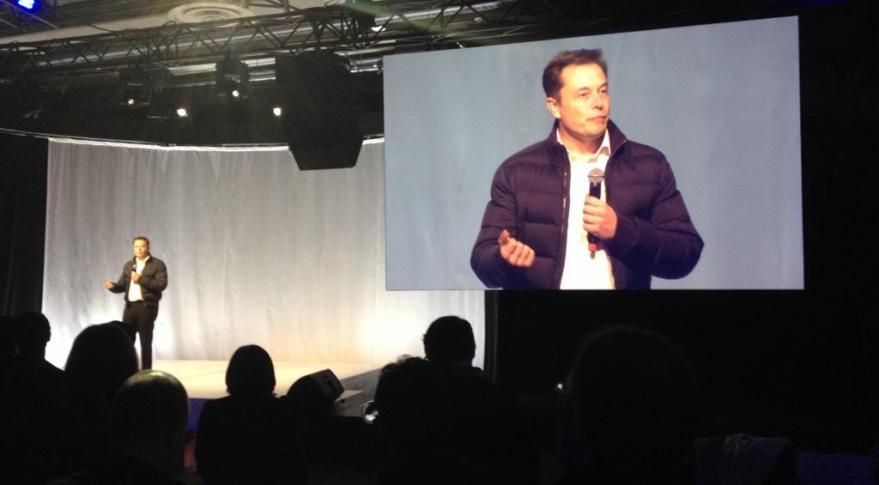SpaceX To Build 4,000 Broadband Satellites in Seattle

PARIS — Elon Musk on Jan. 16 said SpaceX has submitted to international regulators the necessary documentation for a global satellite Internet project to eventually include some 4,000 satellites in low Earth orbit and initial service within five years.
He also said Hawthorne, California-based SpaceX would not be pursuing a stock market listing for many years given the volatility of the launch-services market.
Musk did not provide a name for his satellite project, and there was no immediate way to verify what he or SpaceX have submitted to the International Telecommunication Union (ITU), the Geneva-based United Nations agency that regulates orbital slots and radio spectrum. Also unclear is what radio frequencies the SpaceX network would used to deliver broadband from low Earth orbit.
“There’s multiple elements to the regulatory things,” Musk said in answer to a question during an invitation-only speech in Seattle announcing the creation of the SpaceX satellite factory there. “There’s the ITU filings and we’ve done the filings associated with that.”
The ITU operates on a first-come, first-served basis, meaning any satellite system that had registered to use the same frequencies before SpaceX made its filings would have priority over SpaceX.
Depending on the frequencies selected, a global network in low Earth orbit – Musk said his constellation would be at an altitude of around 1,100 kilometers – would need to avoid interfering with signals from satellites in higher geostationary orbit 36,000 kilometers over the equator.
Musk’s announcement came just two days after OneWeb LLC, formerly called WorldVu Satellites, announced that Virgin Galactic of London and Qualcomm Inc. of San Diego had agreed to invest in OneWeb’s 650-satellite system.
Get the Space.com Newsletter
Breaking space news, the latest updates on rocket launches, skywatching events and more!
Under the name WorldVu, OneWeb has secured ITU authorization for a Ku-band network at 1,200 kilometers in altitude with in-service deadlines in 2018 and 2020. OneWeb, based in Britain’s Channel Islands, will need to avoid the large number of Ku-band telecommunications satellites operating in higher orbit, and will be particularly challenged to operate around the equator given that most Ku-band satellites are in geostationary orbit.
Musk said SpaceX is entering the satellite production business with a new plant based in Seattle in part because there is more money associated with satellite manufacturing than with space-launch services.
“This is intended to be a significant amount of revenue and to help fund a city on Mars,” Musk said. “Looking at the long term, what’s needed to create a city on Mars? Well, one thing’s for sure – a lot of money. So we need things that will generate a lot of money.”
The SpaceX satellites are expected to weigh several hundred kilograms at launch and to use Hall-effect ion-electric thrusters for in-orbit maneuvering. He said SpaceX’s satellite plant would be building its own thrusters, which he characterized as a technology that can be mastered with relative ease.
The SpaceX network would feature user terminals fitted with phased-array antennas inexpensive enough — $100 to $300 – to be purchased the world over to deliver broadband to areas that are unlikely to be served by terrestrial broadband anytime soon. It should take about five years to build and launch an initial constellation that would cover the globe except the polar region.
“We’re really talking about something which is, in the long term, like rebuilding the Internet in space,” Musk said. “The goal will be to have the majority of long-distance Internet traffic go over this network and about 10 percent of local consumer and business traffic. So 90 percent of people’s local access will still come from fiber but we’ll do about 10 percent business to consumers directly, and more than half of the long-distance traffic.”
No SpaceX IPO Before Mars
Musk said his experience as chairman of electric-powered automobile manufacturer Tesla Motors Inc. of Palo Alto, California, whose stock trades on the U.S. Nasdaq market, has taught him a lesson about the fickleness of investors.
“With Tesla in any given week, it’s like dealing with a manic-depressive,” Musk said of the auto company’s roller-coaster stock price.
“I think we won’t take SpaceX public for quite a long time,” Musk said. “When we’re doing regular flights to Mars, that might be a good time to go public. But before then, because the long-term goals of SpaceX are really long term – it takes a long time to build a city on Mars – that doesn’t match with the short-term time frame of public shareholders and equity managers.
“That said, we do offer stock options and restricted stock and we do liquidity events every six months. So we have the company valued by an outside firm every six months, and we do stock buybacks every six months. It gets the best of both worlds, where you have stock liquidity but you don’t have massive fluctuations that you have with a public company…. We’ll go public maybe 20 years from now or something like that.”
This story was provided by SpaceNews, dedicated to covering all aspects of the space industry.
Join our Space Forums to keep talking space on the latest missions, night sky and more! And if you have a news tip, correction or comment, let us know at: community@space.com.
Peter B. de Selding is the co-founder and chief editor of SpaceIntelReport.com, a website dedicated to the latest space industry news and developments that launched in 2017. Prior to founding SpaceIntelReport, Peter spent 26 years as the Paris bureau chief for SpaceNews, an industry publication. At SpaceNews, Peter covered the commercial satellite, launch and international space market. He continues that work at SpaceIntelReport. You can follow Peter's latest project on Twitter at @pbdes.










